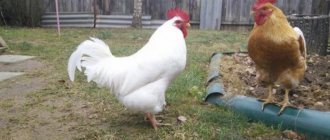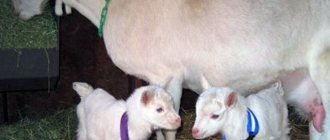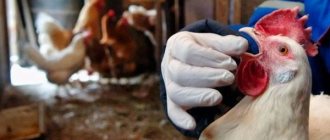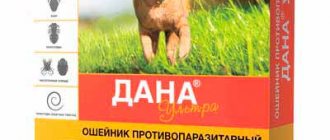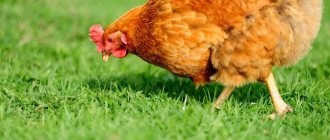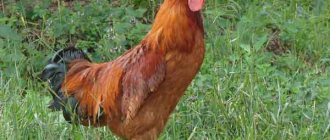The largest breeds of chickens differ from standard ones by their unusually large body weight, which sometimes reaches 5-7 kilograms. As a rule, representatives of such chicken species belong to the meat or meat-egg type, some of them have fighting roots. The weight of giants depends on the orientation of the variety, diet and living conditions in which they are kept. In the article we will look at the characteristics and features of the most famous large chickens.
Cochin
This is one of the oldest chicken breeds, known in Indochina since the 18th century. The birthplace of the breed is considered to be the Cochin region of Vietnam in the Mekong River valley. In China, interesting and unusual birds were considered something valuable and inviolable, because of this, animals served as decoration in the imperial court. When the Anglo-Chinese “Opium” War ended, Queen Victoria often received Cochinquin as a gift.
Chickens became very popular among English poultry farmers and were exported to America. Chickens are still popular and in demand today. Breeding work ended with the success of breeding chickens with different colors. There are partridge, black, white, fawn, and blue birds.
Before the revolution in Russia, they were actively breeding birds on peasant farms. They were especially valued for their high egg production in winter. Today the population has declined, the reason for which is the inflated cost of breeding chickens. Cochins are often kept as ornamental birds and for breeding.
The distinctive features of birds include the following criteria:
- strong and powerful shins;
- thick plumage;
- live weight of chickens – 6 kg, roosters – 4 kg;
- chickens are very hardy, acclimatize well in regions with cold and long winters;
- per year, laying hens produce 110-120 eggs weighing 55-60 g, the color is ocher-brown with a yellow yolk.
Chickens have excellent natural qualities; they are actively used to breed new breeds of meat chickens. The birds were used for the selection of Brahma chickens; on their basis, it was possible to create many breeds of modern broiler crosses.
Philosophy of beauty
So, few will deny that chicken is not always trivial: “egg or meat,” although in the sense of gastronomic perception it is more common. What if you try to change the viewing angle and look at the heroine of our review differently?
Agree, its undeniable advantages become clear, and suddenly it becomes apparent that this creature is very, very good-looking. An elegant arsenal: an amazing fluffy tail, a magnificent comb, “feathery boots” - why not decorate any backyard, front garden and aviary?
Let's take a closer look at the decorative beauties that have confidently established themselves as a distinctive segment of the poultry industry. Watch the video of the most unusual breeds of chickens.
Jersey giant
A large breed of chicken developed in the United States in the 1920s. Breeders paid a lot of attention to the muscles and growth rate of the young animals. It was possible to develop a breed characterized by its unpretentiousness to living conditions. The name of the breed actually refers to the birds.
Chickens are considered excellent laying hens with a calm nature. Both females and males grow quickly and instantly gain weight. The live weight of chickens reaches 3.7-4.5 kilograms. Roosters weigh about 5 kilograms by the age of 12 months.
The poultry farmer needs to take into account some characteristics of birds - they are prone to obesity, and it is important to carefully monitor their diet. Also, the Jersey giant needs a lot of space and when fed for more than one year, the poultry meat becomes less tasty.
Main advantages and disadvantages
The key advantages of large chickens include the following:
- delicatessen meat, which is considered dietary;
- strong immunity - a long period of selection allowed us to obtain healthy chickens that are unpretentious and adapt well to external factors;
- unlimited reproduction - this is possible if there are several unrelated lines and the characteristics of the breed are preserved.
However, chickens also have certain disadvantages:
- late maturation period - chickens produce eggs only at 7-8 months, and gain maximum weight after 1 year;
- low egg productivity - such breeds produce no more than 120 eggs per year;
- tendency to obesity.
Hungarian giant
A lush chicken, from the name of which it is immediately clear that this animal was bred in Hungary. The bird has very impressive dimensions. The Hungarian breeder wanted to breed a bird that could please with excellent productivity. Another goal of theirs was the desire to obtain a variety that was unpretentious, easy to grow, and capable of adapting to any climatic conditions.
To achieve their goals, breeders used Orpingtons, crossing them with local, village chickens with excellent user characteristics. We managed to achieve a good result:
- The birds have a fiery red color. The plumage is somewhat similar to a fox fur coat. In its homeland and in some other countries, the Hungarian giant is called the red broiler.
- Chickens are distinguished by their ability to incubate. They tend to become mothers to young animals twice in one season. Hungarian chickens are characterized by producing viable, healthy offspring that quickly gain weight. The survival rate of chickens is about 95%, but often the chicks suffer due to slow feathering - they need to be kept in a warm room where the temperature and humidity are stable.
- Externally, the birds are unremarkable, except that they have a lot of weight and impressive dimensions. They are characterized by dense feather coats, a proportional body with developed muscles. The weight of an adult rooster reaches 4-5 kilograms, chickens - 3.5-4 kilograms.
- Birds are unpretentious in their diet. They require regular meals containing proteins and vitamins. Animals need a spacious walk. It is believed that birds living in freedom have tastier meat than those kept in cages.
Gilan breed
A giant bird considered very ancient. It is for this reason that it is difficult to answer where this bird comes from. Scientists are more inclined to believe that the laying hen was bred in the province of Gilan, located in Iran. But researchers from other groups refute this version, believing that the Gilans come from Persia.
In Makhachkala, poultry farmers have even united into a club to revive this breed; they are trying with all their might to popularize the breed and make its population numerous.
Distinctive characteristics of the Gilan bird:
- Has a unique appearance. It is characterized by tall stature, an upright body, an elongated neck, and long, but at the same time stable paws. The birds have well-developed muscles, but their high growth does not allow them to be called large barrels. Initially, the variety was considered a fighting bird, because its physique is typical of fighters. Externally, the Gilyan bird is similar to Oryol chickens.
- Gilan hens are considered caring mothers for their chicks. They have a well-developed maternal instinct and are prone to organization. Roosters are strict and uncompromising; they will not allow a stranger into their territory. They will not be able to come to terms with being next to other types of chickens, but they do not quarrel with each other.
- The weight of Gilan birds varies from 6 to 11 kg. Animals grow within one and a half years. Puberty comes late. Egg laying begins at the age of 1-1.5 years. Females produce about 150 large eggs weighing up to 80 grams throughout the year.
- The advantage of the breed is its increased resistance to cold and frost, high immunity, endurance and ease of care.
Characteristic
Girls are ready to deal with the consequences of their actions, even if they have to pay a high price. They are one of the calmest people among all the zodiac signs. They have an ideal internal balance that has no equal.
Optimistic and tender, have a good taste. They are sophisticated people and people always ask them for advice and opinions on how to dress and take care of their hair. The woman talks a lot and on different topics. She knows how to behave in society and is always open to conversation.
Sensitive Libra-Roosters are great intellectuals and can charm anyone. Ladies are skillful and accurate, have an analytical mind, and know how to judge a situation clearly, regardless of the circumstances.
Interested in their own appearance and how others perceive them. For them, the most important things in life are family, health and home. They try to surround themselves with smart and influential people. Words in any conversation are chosen carefully before they decide to say anything.
Appreciating everything that surrounds her, such a woman is calm, she is able to understand the point of view of other people. For this reason, she always has many friends. Calm and mature, very smart. She approaches various situations with tact, and only takes tough action when required. Psychologists recommend that she not express herself openly and rudely, since such behavior is not typical for this sign.
If I were more observant, I would learn to use this to my advantage. This girl needs to feel freer to be happy. You can't criticize her too much because you might offend her.
Don't be fooled by this lady's cheerfulness, she is not the kind of person who will trust others easily, regardless of whether the other person is polite or not. If you manage to gain a little trust, a woman will easily tell you about every detail of her life. The desire to share can be interpreted as a weakness of character, since such revelation often leads to disappointment.
The fact that they like to talk so much can work against them. When something bothers a Libra girl, she speaks much faster.
Malin
The unusual cuckoo coloration gave rise to the name of the birds. Breeders from Belgium wanted to create a large hen so that its meat would have a unique taste. To achieve the desired selection, Flanders, Shanghai, Brahm and other chickens were used.
Over several generations they managed to achieve lasting results. For more than a hundred years, Malin chickens have been successfully bred by farmers from different countries.
Birds have many advantages:
- They are not prone to obesity. Their entire carcass consists mainly of muscle mass.
- Raspberries have a trapezoidal, well-proportioned body. The distinctive features of the birds are a strong, wide back, a rounded chest, and powerful paws. The peculiarity of the bird is not only in its dimensions (it looks decorative due to the feathered legs and a beautiful pattern on each feather), but also in its unique color - each feather is decorated with a striped pattern made in the form of gray and white lines.
- The weight of a rooster reaches up to 5.5 kg, a chicken – up to 4.5-4.7 kg. But some poultry farmers can boast of incredible results - they often showed birds weighing 7-8 kg at exhibitions.
- Adult chickens are fed three times a day. Animals should not be overcooled; they require optimal temperature and humidity. Birds are often attacked by parasites due to their lush plumage. Frequent prevention will be useful. Birds also suffer from a lack of vitamins during the period of growth and laying.
- Maternal instinct is present in birds, but not always. For this reason, many breeders do not risk placing Malin hens on the nest; it is possible that the birds will leave it in a couple of days. Chickens are tenacious, the average survival rate is 97%.
Description of the rooster
In the formation of a chicken flock, a special role is assigned to the rooster. The latter always looks impressive against the backdrop of modest females: colorful plumage, long flowing tail, pointed feathers in the dorsal and neck area, spurs on the legs. Adult males have a bright crest and dangling earrings located on the sides of the beak and performing the same function with the crest: directing blood flow to the skin and regulating the temperature of the body.
The rooster flies rarely and over short distances; in case of danger, it prefers to run quickly. At the end of autumn - beginning of winter, cockerels begin molting, which lasts approximately 6 weeks. It begins to crow at 4 months of age.
The bird sleeps on one leg, tucks the other under itself and hides its head under the wing on the side where the leg is tucked. Roosters and hens are omnivores; along with seeds and insects, they can peck a small lizard, snake or young mouse. Drinking water is an important factor for successful growth and development. Its deficiency negatively affects the egg production of females.
Brahma
Brama are meat and egg chickens with excellent weight indicators. The peculiarity of the breed is its attractive appearance, the presence of lush and soft plumage. Birds have peculiar feather “pants” on their legs. There are animals with light, dark and partridge colors:
- Light colored birds have been widespread in Europe since the 50s of the last century. They have white plumage and dark feathers on the tail and neck. They are distinguished by good productive qualities and unusual appearance. His posture is proud, a little important. The weight of chickens is about 3-4.5 kg, roosters - at least 4.5 kg.
- Dark chickens are similar to their light counterparts, but have dark plumage with light feathers on the neck and back. In addition to being characterized by excellent meat qualities, they are valued for their external characteristics - the birds often decorate the chicken coop. They have a calm character and do not mind being around other breeds. A dark rooster weighs about 5 kg, sometimes 6-7 kg. The weight of chickens reaches 3-4.5 kg.
- Partridge representatives in appearance practically do not differ from white and dark birds according to the description. The only difference is the red and black color on a fawn background. The weight of chickens is close to 3-4 kg, roosters - 3.5-4.5 kg.
Plymouth Rock
The breed was bred in the middle of the last century by US breeders. The name consists of two parts: Plymouth - the name of the city that is the birthplace of chicken, and “Rock”, which means rock - as a symbol of the large size, strength and endurance of the breed. Chickens are also characterized by a large amount of meat of the highest quality, as well as the ability to quickly gain weight.
Plymouthrocks come in a variety of colors, but white hens are the hardiest and are therefore the most frequently bred. These are the largest chickens in size.
Chickens are wide in the chest, have a not very large head, a well-feathered neck and tail, a short yellow beak and red eyes.
Plymouth rocks are raised for both meat and eggs, but meat production is considered the main one. The meat of these chickens is tender and tastes similar to broiler meat. The disadvantage is the not very appetizing yellowish tint of the pulp.
The breed is unpretentious to climate fluctuations, calm, and has good immunity. The growth of young animals occurs quite quickly - at the age of six months, females begin to lay eggs, which is a record among chickens.
The chickens are fed the same food as their parents, but the food should be crushed and corn flour, cottage cheese, hard-boiled eggs and chopped herbs should be added to it.
Chickens that are sick or do not meet the standard are culled.
Broiler
Growing broilers helps to quickly obtain cheap meat products, which is especially beneficial for large poultry farms and farmsteads. The first broilers were produced by English poultry farmers who crossed two large breeds.
Broilers are not a breed, they are a hybrid with loose genetic characteristics that do not appear in subsequent offspring.
Every year, poultry farms manage to breed new species; usually for these purposes they use white Cornish, Brahma, Rhode Island, Langashan, Cochin, Plymouth Rock, and Cuchin chickens. A distinctive feature of broilers is their unpretentiousness in feed and maintenance, and increased resistance to diseases.
Chickens tend to quickly gain muscle mass, but they are no larger in size than large chickens. The weight of the largest broiler Ross-708 on the 35th day of life is 2.9-3 kilograms.
Orpington
The largest English breed, Orpington, was bred in the second half of the 19th century in the city of the same name. Breeders at that time wanted to get a chicken with exclusively white skin without yellowness. This was required by English quality standards. Chickens were crossed with the Cochin breed, thanks to which it was possible to obtain not only an exotic-looking animal, but also a bird with high productivity.
Poultry farmers immediately appreciated the bird. In addition to their attractive appearance, representatives of the breed produced an average of 160 large, brown eggs weighing up to 70 grams. High meat indicators were also noted. At one year of age, the weight of roosters was up to 5 kilograms, sometimes even 6-7 kilos. Chickens weigh up to 3.5 kilograms.
From Cochins, Orpingtons got their amazing, majestic appearance. The birds have a massive body with a wide chest, a small head, on which there is a leaf-shaped crest and rather long earrings.
There are birds of different colors: hawk, yellow, black, brown, gray, white, ash-gray. Chickens are easy to care for, but young animals grow slowly and require large feed investments.
Master Gray
The color was the main reason for getting this name. The bird's white plumage has gray and black spots. There are black feathers around the neck like a necklace. The bird was bred in France by Hubbard breeders. The breed is considered a meat-egg breed.
A distinctive characteristic of the bird is its highest productivity. The maximum weight of chickens reaches up to 4 kilograms, roosters - up to 7 kilograms. Over the course of a year, laying hens produce up to 300 large eggs weighing 70-90 g. They reach sexual maturity at 3.5 months.
Poultry farmers especially value this breed due to its almost 100% survival rate of young animals and rapid weight gain. The advantage is that the bird does not suffer from a closed space; it can be kept in cages. The animal has dense meat, similar in consistency to the product of domestic chickens. At the same time, the meat is tender and tasty. Birds have highly developed pectoral muscles - this contributes to a high yield of dietary white meat, suitable for preparing baby food.
Dream Interpretation - Huge dog
The dream is written out as from Miller's interpretation. A very colorful and transparent dream for interpretation. Just recently you made an influential friend. In some cases, the size of the dog may indicate the degree of your affection, and not its influence. In this case, the dream carries information about your desire to please this new acquaintance. It should also be noted that this friend may not be so new, but his role in your eyes has changed quite recently. You are slightly wary of him, although you have high hopes for the relationship. Trying on clothes means looking at him as a partner or even a companion. And the most interesting aspect. His collar is torn - this may indicate that he is divorced or that today his heart is in search. A different interpretation of this point suggests that you may lose it if you do not take measures to restore parity in the relationship in the near future. This means that you must become as necessary to him as he is to you. The dream suggests that there is no need to be afraid of urgent changes, but delays in this matter are fraught with losses. Figure it out with yourself, who is this big and shaggy dog and is he ready to try on the clothes you sew? Good luck! Sincerely, Diver. Interpretation of dreams from the Dream Interpretation of the House of the Sun
Individual record holders
Achieving your own records for raising birds has gained popularity for a very long time. Today, many chicken owners compete with each other, trying to achieve maximum results in order to go down in history. Some just want to share their achievements and give some recommendations to novice poultry farmers.
The largest birds that became famous thanks to their owners and became famous throughout the world are presented:
Little John
This name was given to the Brahma rooster, received from the owner, Jeremy Goldsmith. The giant bird lives in England, Essex. At the age of 12 months, little John was already 66 centimeters tall. It is more likely that by the second year of life the bird will become even taller. The owner does not directly answer what contributed to such a rapid growth of the rooster, but hints that he prepares a special diet for the pet.
Jeremy Goldsmith allows the kids to come in for rooster inspections, and doesn't even mind being fed chips and popcorn.
The previous record holder Melvin was 6 centimeters shorter than Little John. It was also owned by Jeremy Goldsmith.
Big Snow
This nickname was given to the officially registered record rooster in the heavyweight category. The bird belonged to Australian Ronald Alldridge, originally from Queensland. The registration date of the rooster was in 1992, at that time the bird’s weight was 10.36 kilograms, its withers reached a height of 43.2 centimeters, and its chest circumference was 84 centimeters.
The bird breed is quite rare - Whitesulli. Representatives can reach a weight of 8-10 kilograms. The owner of the animal was very proud of his pet, as evidenced by many photos with celebrities, which also depicted Big Snow. In the fall of the same 1992, the bird died of natural causes.
Rooster Coburn
Record holder from the Brahma breed, lives in the UK. His interesting name was given to him in honor of the main character of the American film True Grit. The giant weighs 11 kilograms and is 91 centimeters tall. The owners of Rooster Coburn are a married couple - Mr. and Mrs. Stone. They claim that the bird is a real guard of its chicken coop, because it does not even allow foxes to approach it.
Photo gallery
Photo 1. Rooster Coburn in his chicken coop
Photo 2. Interesting color of Orpington chickens
Photo 3. Jersey giant on a walk
Features of keeping large chickens
The largest chickens are often low maintenance. But the poultry farmer needs to take into account some features associated with breeding heavyweights:
- The chicken coop should be clean. It is necessary to regularly clean the poultry house - this will ensure good health for the birds and protect them from various diseases.
- Large birds need space, this should be taken into account when preparing the chicken coop before breeding birds. It is advisable for birds to go out for a walk. An aviary with 1-2 birds per 1 square meter will be comfortable for animals.
- Due attention is paid to ventilation. Bird excrement releases ammonia, which accumulates on the floor and has a negative impact on the health of the animals.
- When building a poultry house, it is important to take into account the size of the birds. Animals will not be able to fly over the fence or jump. In accordance with this, nests and perches are not placed high - hens should have free access to them. As a last resort, the poultry farmer can build a ramp.
- Due to the fact that females are prone to frequently crushing eggs or throwing them out of nests, supervision is necessary for them. This will avoid the loss of unborn offspring.
- It is recommended to cover the floor in the poultry house with sawdust, straw, grass or other soft materials. Heavy weight often causes falls, even from low heights, which can lead to injury.
- Bird combs are very sensitive and at temperatures of 0 degrees and below they can be damaged. During the cold season, it is advisable to move birds to a warm room or lubricate their combs with oil.
There are numerous large breeds of chickens in the world. All of them are united by large dimensions, unique appearance, high egg and meat productivity. Most poultry farmers are engaged in breeding large birds for the further sale of eggs and animal carcasses - this helps to obtain excellent benefits.
0
0
Copy link


